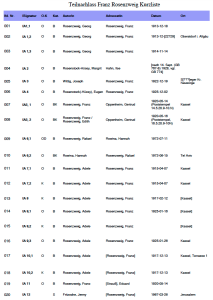Welcome! The following posts will explore the process of visualizing the metadata for about 900 archival documents belonging to the partial Nachlass of the German-Jewish philosopher, theologian, and translator, Franz Rosenzweig (1886-1929). The occasion for this work is a conference to be held at the University of Pennsylvania, “Mapping, Mining – Redefining? The Digital Turn in the Humanities,” (April 23-25, 2015) in the Kislak Center of Van Pelt Library. Rosenzweig’s partial archive came to the University of Kassel Library in 2006 via Rosenzweig’s daughter-in-law Ursula Rosenzweig and contains over a thousand documents pertaining to Rosenzweig, including letters to friends and family, diaries, and photographs. The often unpublished materials in the archive promise new insights into the context and background of Rosenzweig’s thinking on religion, culture, and Judaism and, given its size and accessibility, a prime example of a moment when digital techniques offer novel inroads to remap, rethink, and redefine traditional humanistic lines of inquiry.
In my presentation, I will discuss visualizing the data contained in the finding aid graciously provided by the University Archive. At its core, this process will entail the movement or “conversion” of data from one medium to another – from PDF to spreadsheet, from spreadsheet to computer-generated visualization – and will raise many questions central to theories of translation. Both “conversion” and “translation” are central to Rosenzweig’s philosophy and religious and cultural thinking, Rosenzweig himself nearly converting to Christianity in 1913 and later undertaking large Hebrew-German translation projects. What, then, do digital techniques reveal to us about Rosenzweig’s life and work through his Nachlass? Conversely, how does Rosenzweig’s theory of translation enable us to think more critically and closely through the acts of translation that make up the process of data extraction, refinement, and visualization? And, perhaps, is “translation” a more precise concept than the curiously theologically-laden “conversion” for understanding what happens when we transfer digital information from one medium to another?
Over the next few posts to this blog, which given the medium of blogging hope to strike a more causal, less formal tone, I will:
- Outline Rosenzweig’s theory of translation through the afterword to his translation of the medieval Hebrew poet Judah Halevi,
- Provide tools to visualize the metadata of Rosenzweig’s Nachlass using the programs Tabula, Google Refine, and Palladio. (I will demonstrate how to use these tools in a workshop on Saturday, April 25th).
- Analyze not just what the visualizations tell us about Rosenzweig, but also the ways in which an idea of translation saliently informs the process of data visualization, if not the Digital Humanities writ large.
Before we begin, I would like to thank Thomas Padilla and Devin Higgins of Michigan State Libraries for their guidance with the visualization and the organizers and sponsors of “Mapping, Mining – Redefining” for including me in the program. It’s an honor to be able to work with all of you.
